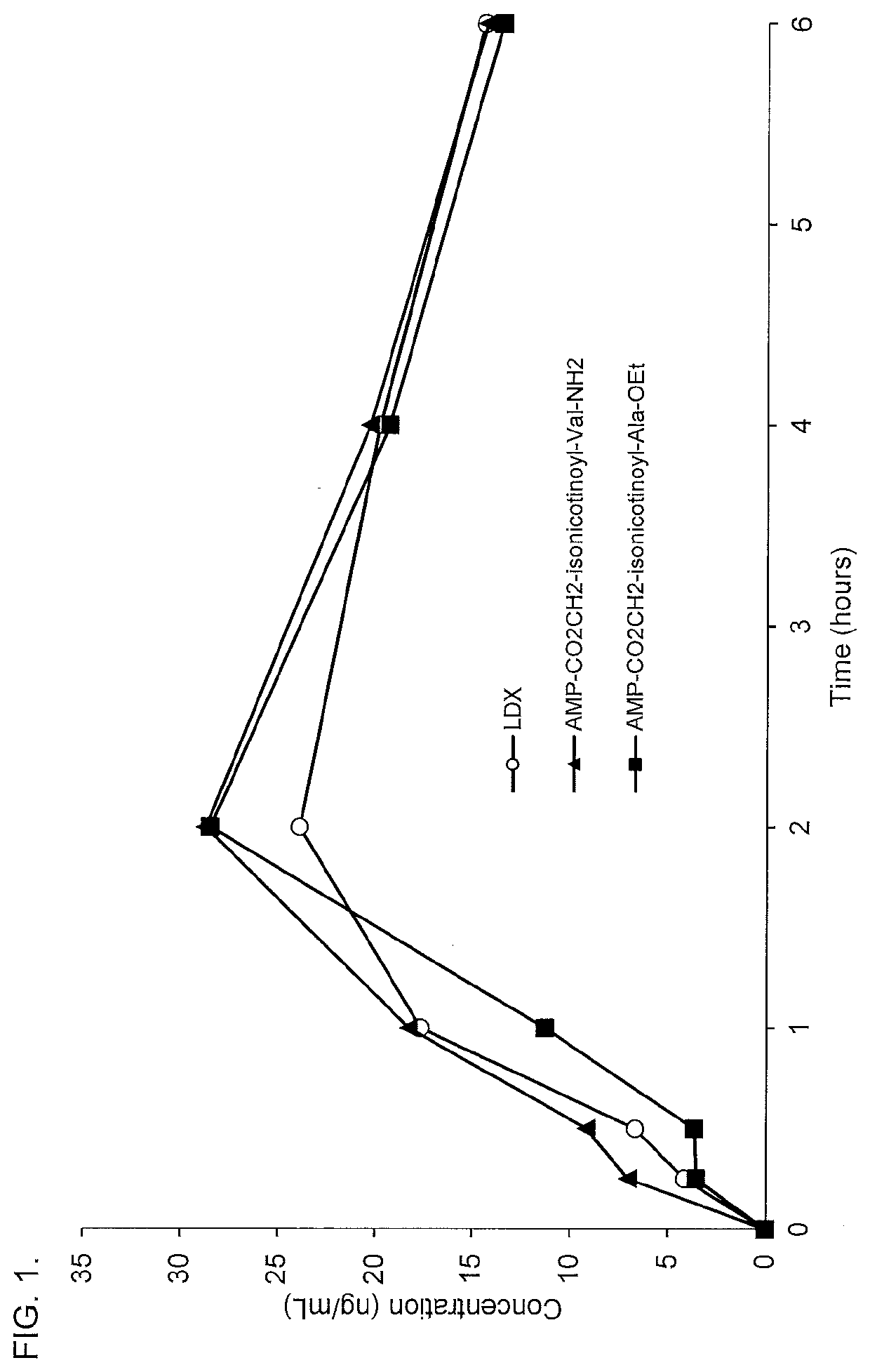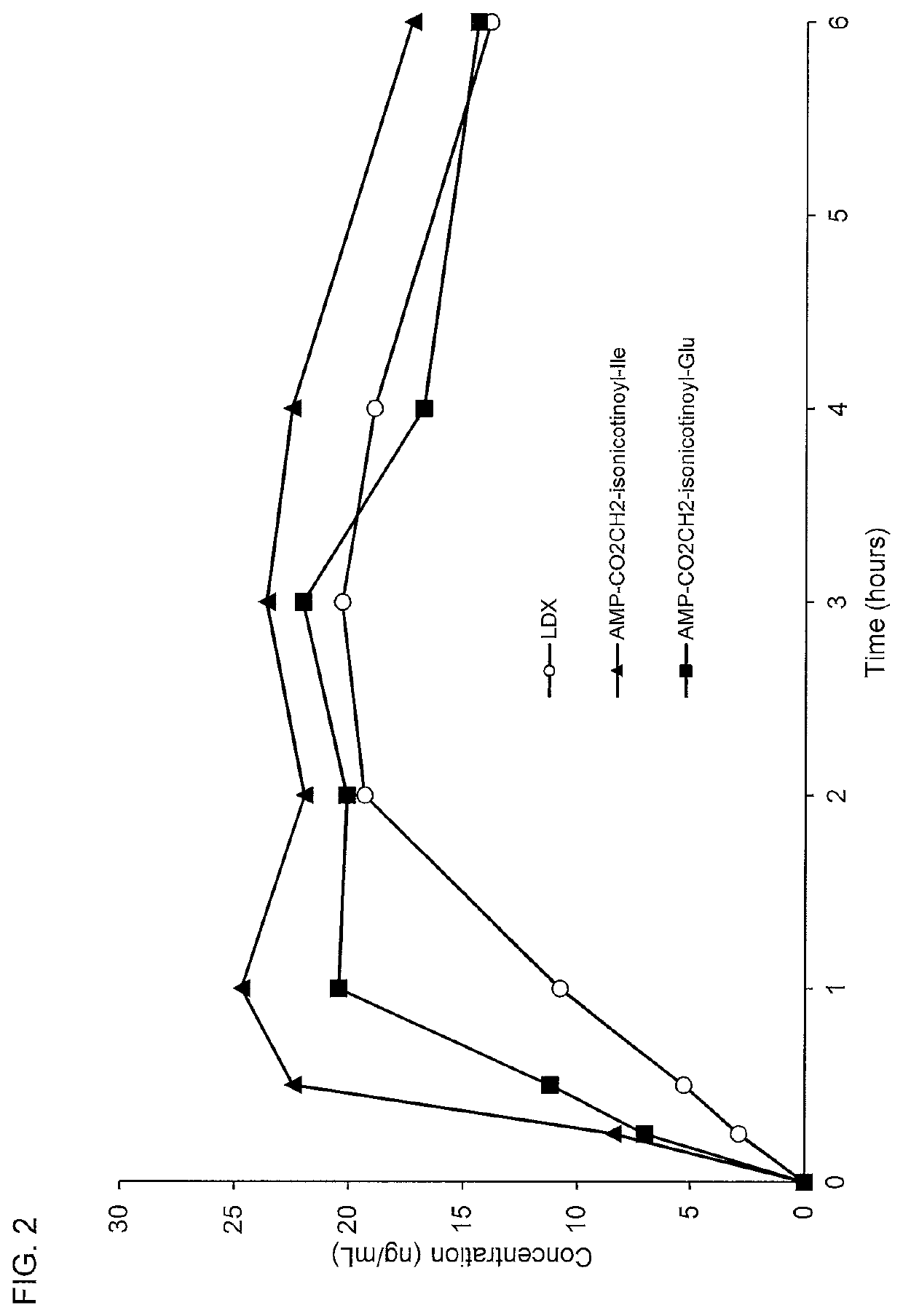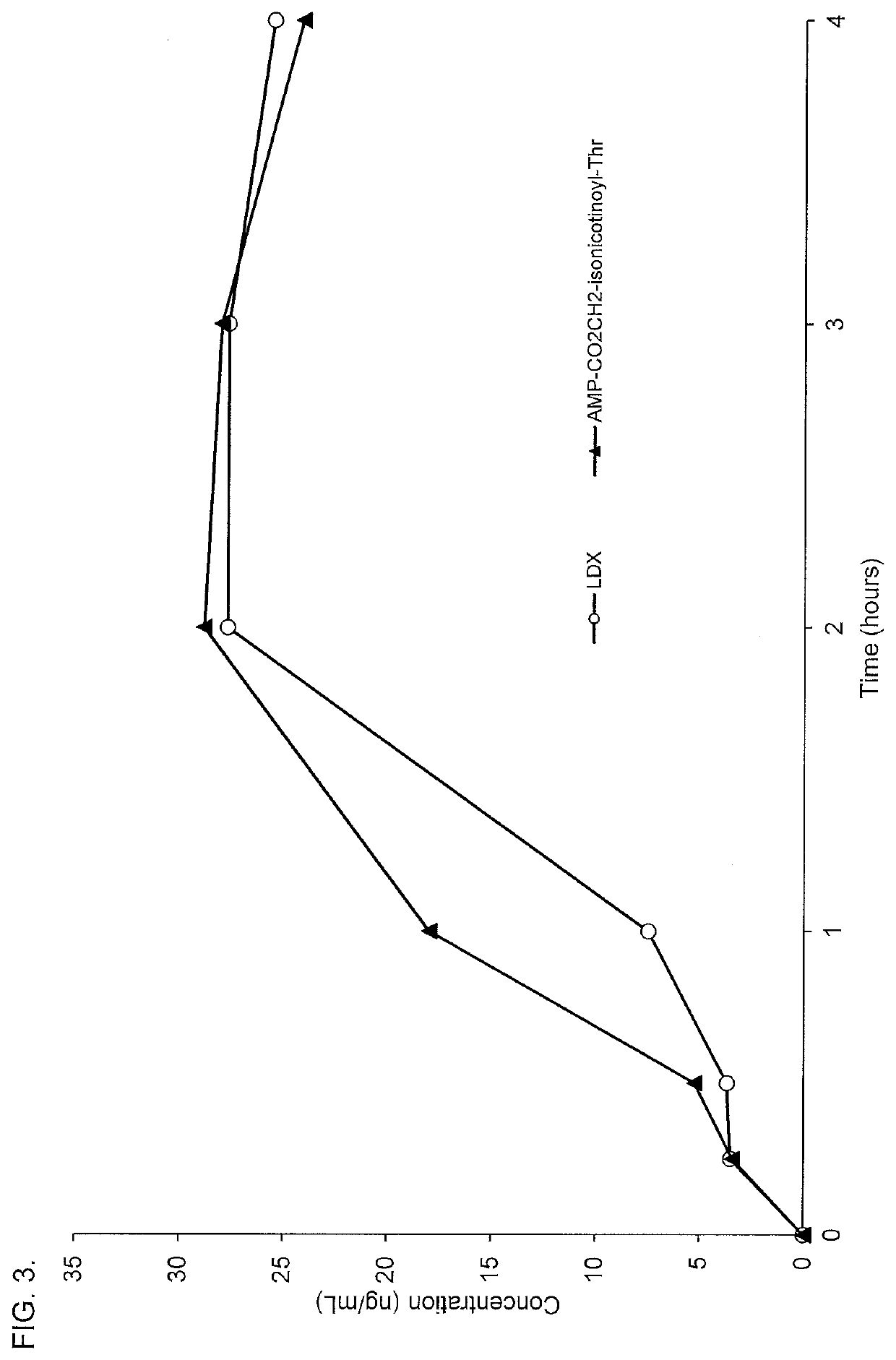D-amphetamine compounds, compositions, and processes for making and using the same
a technology of d-amphetamine and compounds, applied in the field of new compounds and compositions of d-amphetamine, can solve the problems of increasing the number of prescriptions for adhd therapy in the adult population, outperforming the growth of the pediatric market, and a wide range of potentially undesirable side effects, so as to reduce abuse potential or abuse liability, reduce abuse potential or prevent abuse, and improve battlefield alertness
- Summary
- Abstract
- Description
- Claims
- Application Information
AI Technical Summary
Benefits of technology
Problems solved by technology
Method used
Image
Examples
example 1
macokinetic Study
[0262]Conjugates of d-amphetamine, and d-amphetamine sulfate or lisdexamfetamine dimesylate comparator compound were dissolved in an appropriate vehicle and administered in rats via oral gavage at doses of 5.6 μmol / kg. Whole blood samples were collected via retro-orbital bleeding at 0.25, 0.5, 1, 2, 4, and optionally at 3 and 6 hours postdose. Blood samples were centrifuged and the resulting plasma samples were collected for analysis of amphetamine concentrations by LC-MS / MS.
[0263]The oral pharmacokinetic plasma concentration-time profiles are shown in FIGS. 1-17. A summary of the oral pharmacokinetic parameters is provided in Table 5 and Table 6.
TABLE 5Oral PK Parameters for d-Amphetamine Conjugates Administered in Rat Using a 4-hour Time CourseCmaxAUC0-4 hrTmaxConjugate(ng / mL)(hr*ng / mL)(hours)AMP-CO2CH2-isonicotinate(tBu)22.860.12.8AMP-CO2CH2-isonicotinoyl-Ala66.5167.51.9AMP-CO2CH2-isonicotinoyl-N-Me-Ala50.9123.72.0AMP-CO2CH2-isonicotinoyl-Asp29.872.32.0AMP-CO2CH2...
example 2
us Pharmacokinetic Study
[0264]Conjugates of d-amphetamine, and d-amphetamine sulfate or lisdexamfetamine dimesylate comparator compound were dissolved in an appropriate vehicle and administered in rats at doses of 5.6 μmol / kg by injecting the solution into the tail vein. Whole blood samples were collected via retro-orbital bleeding at 5 minutes and at 0.25, 0.5, 1 and 2 hours postdose. Blood samples were centrifuged and the resulting plasma samples were collected for analysis of levorphanol concentrations by LC-MS / MS.
[0265]The intravenous pharmacokinetic d-amphetamine plasma concentration-time profiles are shown in FIGS. 18-26. A summary of the intravenous pharmacokinetic parameters of d-amphetamine is provided in Table 8.
TABLE 8Intravenous PK Parameters for d-Amphetamine Conjugates Administered in RatCmaxAUC0-2 hrTmaxConjugate(ng / mL)(hr*ng / mL)(hours)AMP-CO2CH2-isonicotinate(tBu)7.811.30.72AMP-CO2CH2-isonicotinoyl-Ala-OEt24.732.40.52AMP-CO2CH2-isonicotinoyl-Gly25.127.30.08AMP-CO2CH2...
example 3
l Pharmacokinetic Study
[0266]Conjugates of d-amphetamine, and d-amphetamine sulfate or lisdexamfetamine dimesylate comparator compound were dissolved in an appropriate vehicle and administered in rats at doses of 5.6 μmol / kg by slowly adding the respective dosing solution drop-wise and alternating into the nasal openings. Whole blood samples were collected via retro-orbital bleeding at 5 minutes and at 0.25, 0.5, and 1 hours postdose. Blood samples were centrifuged and the resulting plasma samples were collected for analysis of amphetamine concentrations by LC-MS / MS.
[0267]The intranasal pharmacokinetic plasma concentration-time profiles are shown in FIGS. 27-35. A summary of the intranasal pharmacokinetic parameters is provided in Table 9.
TABLE 9Intranasal PK Parameters for d-Amphetamine Conjugates Administered in Rat Using a 1-hour Time CourseCmaxAUC0-1 hrTmaxConjugate(ng / mL)(hr*ng / mL)(hours)AMP-CO2CH2-isonicotinate(tBu)51.819.90.08AMP-CO2CH2-isonicotinoyl-Gly69.020.50.08AMP-CO2CH2...
PUM
| Property | Measurement | Unit |
|---|---|---|
| time | aaaaa | aaaaa |
| structure | aaaaa | aaaaa |
| mixture | aaaaa | aaaaa |
Abstract
Description
Claims
Application Information
 Login to View More
Login to View More - R&D
- Intellectual Property
- Life Sciences
- Materials
- Tech Scout
- Unparalleled Data Quality
- Higher Quality Content
- 60% Fewer Hallucinations
Browse by: Latest US Patents, China's latest patents, Technical Efficacy Thesaurus, Application Domain, Technology Topic, Popular Technical Reports.
© 2025 PatSnap. All rights reserved.Legal|Privacy policy|Modern Slavery Act Transparency Statement|Sitemap|About US| Contact US: help@patsnap.com



